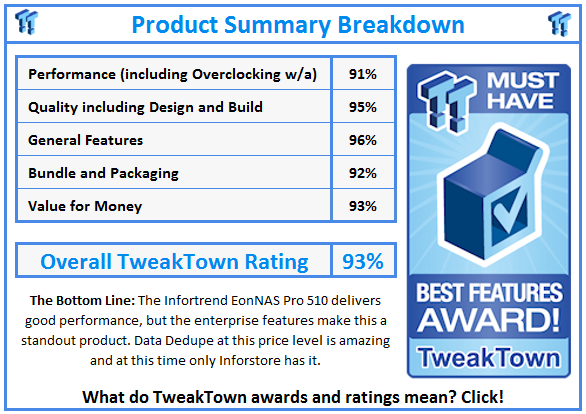Introduction
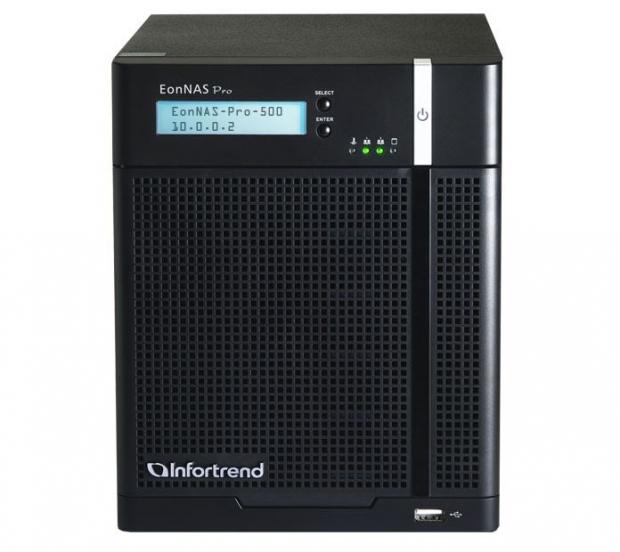
Infortrend delivered the first dual-bay NAS we would ever consider purchasing. In our EonNAS Pro 200 review we glossed over the Infortrend story, but in order to tell you about the EonNAS Pro 510, we first have to tell you a bit more about the company. In our research, we tracked Infortrend back to 1993, when the company first shipped an EISA-to-SCSI controller. To put this into perspective, Thecus and QNAP started in 2004, while Synology came to be in 2000. We test many products from Thecus, QNAP and Synology and their names often come up when shopping for a NAS.
While Infortrend may not be a household name, I use that loosely, maybe a nerd's house, but that's beside the point. Infortrend isn't well known for their entry-level NAS products. The smaller units like the EonNAS 200 we looked at two months ago and the EonNAS 510 that we're looking at today are newer product categories for the company. IT administrators who make purchasing decisions know the Infortrend name, mainly from their large-scale SAN, iSCSI and fiber channel products.
Infortrend now has products for small businesses and home office users. The EonNAS series scales from 2-bays to 16-bays. In this one series, Infortrend manages to scale the entire product lines from both Thecus, QNAP and Synology.
Today we're looking at the Infortrend EonNAS 510, the company's newest 5-bay NAS. Going through Infortrend's milestone page, we found a number of firsts for the company and the 510 Pro should add another one. The EonNAS 510 Pro has a feature not on the EonNAS 200 we reviewed months ago, and this feature is normally reserved for much higher priced models. Deduplication or dedupe for short.
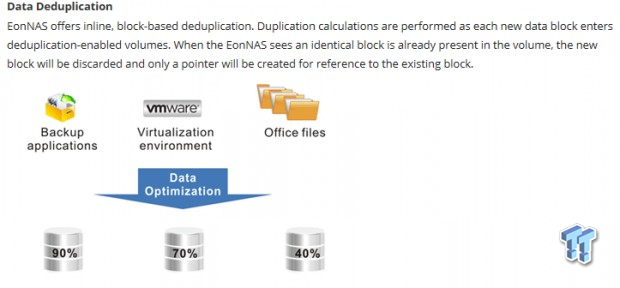
We hear a lot about dedupe on the enterprise side, especially on new flash based SAN products. The technology allows you to store more data on a storage device without the performance hit associated with compression.
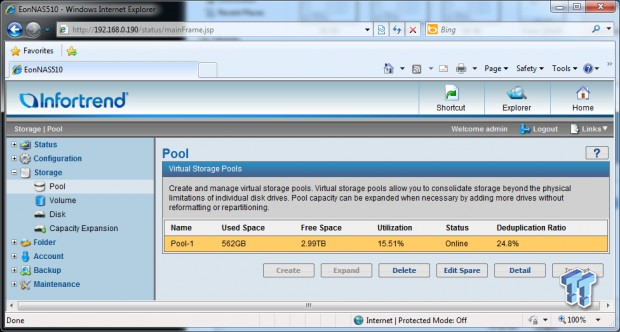
Soon we'll publish a full article on data dedupe and use the Infortrend EonNAS Pro 510 as our base. Here we see an image from early testing that shows a near 25% reduction in on disk data thanks to dedupe. The technology opens the door for solid-state based iSCSI, databases and even high availability storage for office use.
Hardware Specifications and Pricing
Modern NAS servers have moved beyond data storage through a wire network. In order to get the most out of a NAS you need to look at the extra I/O hardware and the mountain of potential software features.
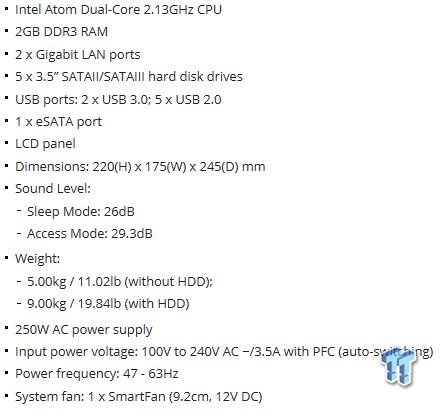
The Infortrend EonNAS Pro 510 has an Intel Atom dual-core processor running at 2.13GHz. Feeding the processor is a single 2GB DDR3 DRAM SODIMM. The Intel Atom processor has become the standard for most high quality NAS products priced under $1000. Many of the model's we've tested over the past six months shipped with just 1GB of DDR3 memory, but the EonNAS Pro 510 doubles that from the factory.
This is a five-bay unit, but Infortrend offers the EonNAS Pro x10 Series in two to eight bays with the price scaling as the drive count increases. Dual gigabit Ethernet ports get your data to the network and the EonNAS Pro 510 includes a number of extra connections. Those include two USB 3.0 ports, five USB 2.0 ports and a single eSATA connection.
Infortrend's documentation and spec sheet shows support for JBOD, RAID 0, RAID 1, RAID 10, RAID 5 and RAID 6. We never managed to find RAID 10, even with just four drives installed in the NAS, the setting never appeared in the options list. Most administrators will run this unit in RAID 5 or RAID 6 for data redundancy, but we wanted to point out the RAID 10 issue since Infortrend's website specifically states it's an included feature.
Given the extensive background and enterprise nature (more on this on the next page), you may think the EonNAS 510 Pro is a bank breaker. After reviewing Google shopping, we found that not to be the base. Provantage currently lists the Infortrend EonNAS 510 at $667.44 at the time of writing, more than $200 less than the QNAP TS-569 Pro, another 5-bay SMB NAS with the same Intel Atom 2.13GHz processor, but only 1GB of DRAM.
Software Features
NAS products are equal parts hardware performance and software features. One compliments the other in a balanced product. You need more hardware performance to run more software features at the same time.
Just because a NAS has the ability to run SQL doesn't mean the hardware will let you run SQL at a high rate of speed while a user downloads Bit Torrent, watches YouTube and decompress an NZB file.

The trend over the last few years has been to load NAS products, even higher end enterprise units, with a massive list of consumer features. Infortrend went the other way and doesn't include Bit Torrent, NZB, media player and other consumer-focused functions.
Instead of consumer features, we get a long list of true enterprise features like a ZFS file system, data dedupe, data compression, corrupt data self-healing, snapshot, pool mirror and remote replication. None of these CPU intensive features will slow due to a rogue administrator downloading Dora via the NAS to take home to the kids.
Packaging
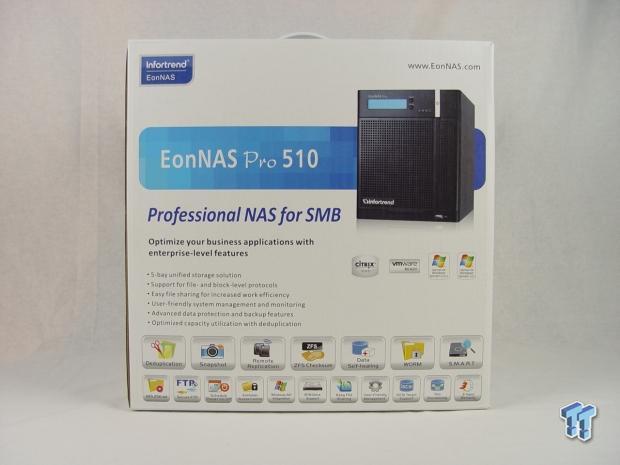
Infortrend has a nice full color retail package for the EonNAS Pro 510. I haven't discovered Infortrend products in any of my local computer stores or big box retailers yet, but the package is ready for a big box invasion.
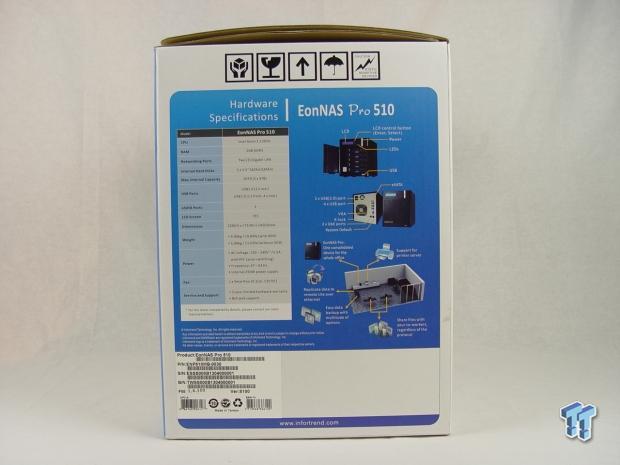
The full product specifications and feature list can be found on the package and images of the product with descriptions can be found as well.
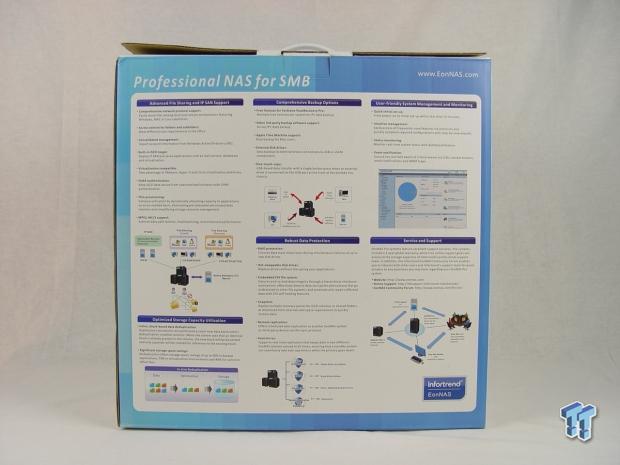
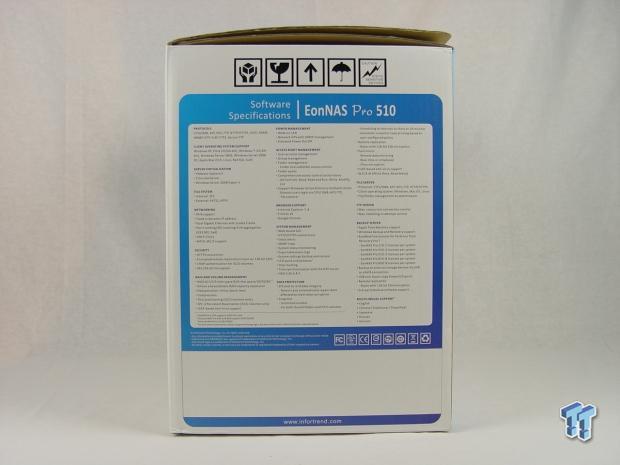
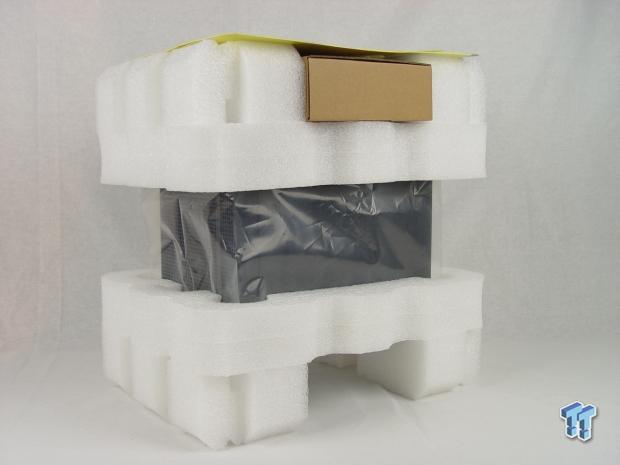
Infortrend did a really good job on the inner package with the NAS buried deep in foam for protection in shipping.
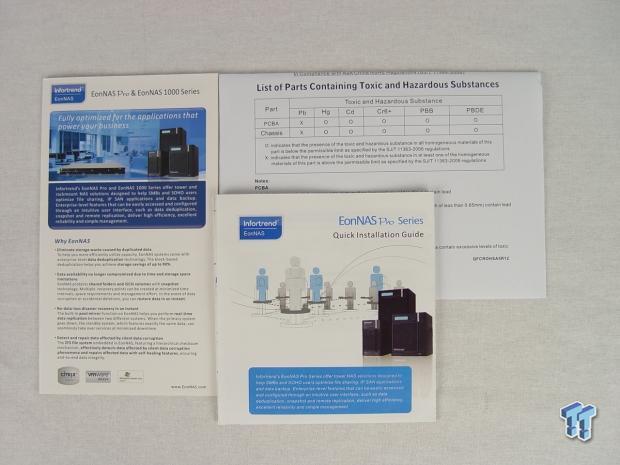
Purchasers get a fair amount of printed documentation.
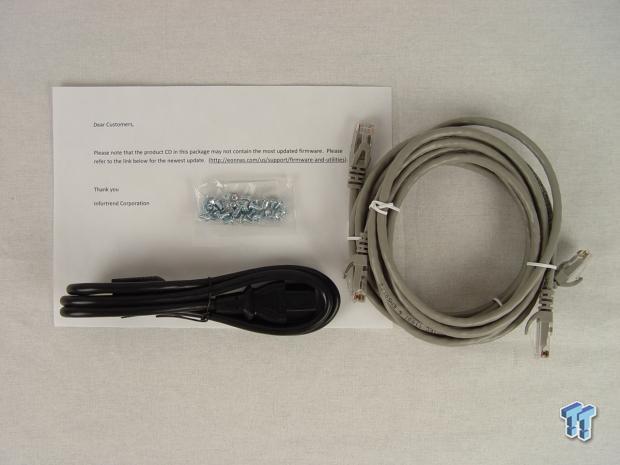
Infortrend EonNAS Pro 510
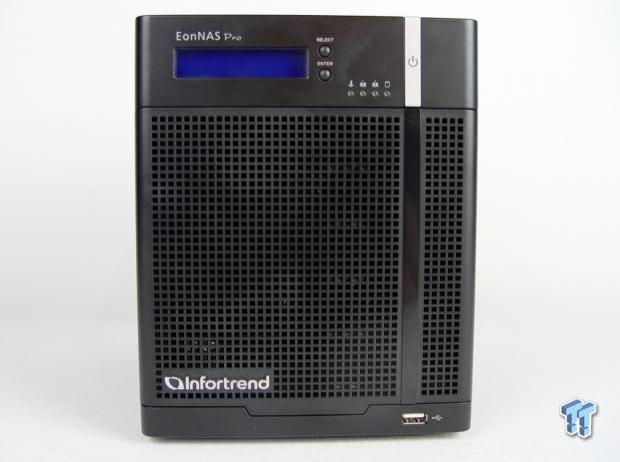
Here we get our first look at the EonNAS Pro 510. The unit doesn't have an overbearing amount of LEDs that dance or flash for little to no reason.
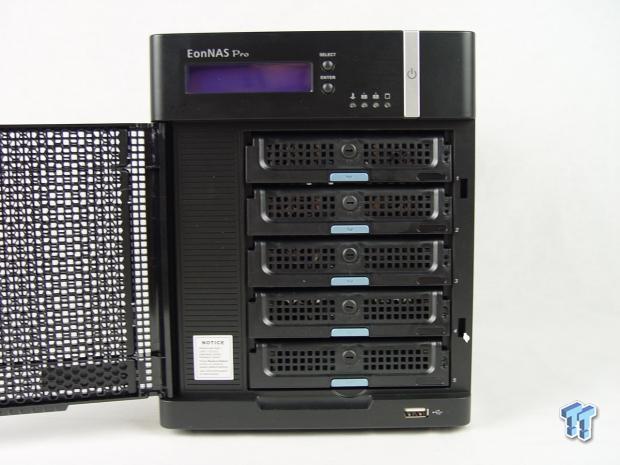
The drive sleds have individual locking mechanisms, but the front door doesn't lock.
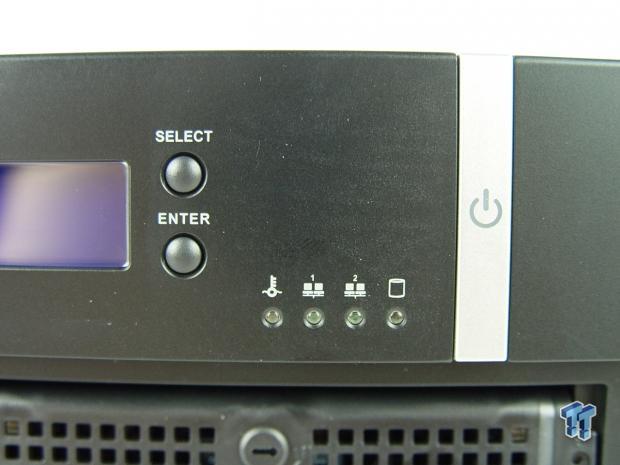
You can configure your NAS with the front display and two-buttons. The power button is easily identifiable. There are four small LEDs on the front face that show an over temperature warning, network activity and disk activity. Each drive sled also shows drive activity.
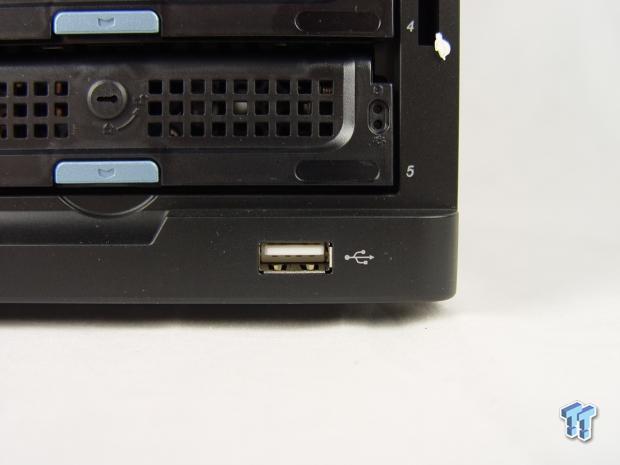
A single USB connector on the front makes backing up your thumb drives easy. The front USB port is 2.0, the two 3.0 ports are both on the back of the NAS.
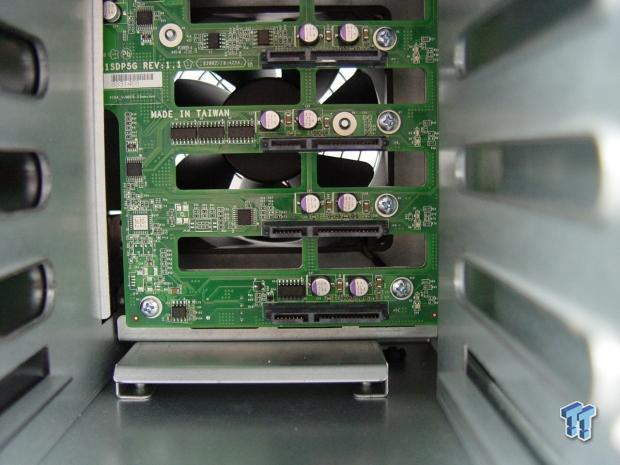
I was a bit surprised to see the EonNAS Pro 510 is SATA only. The connectors aren't keyed for SAS HDDs.
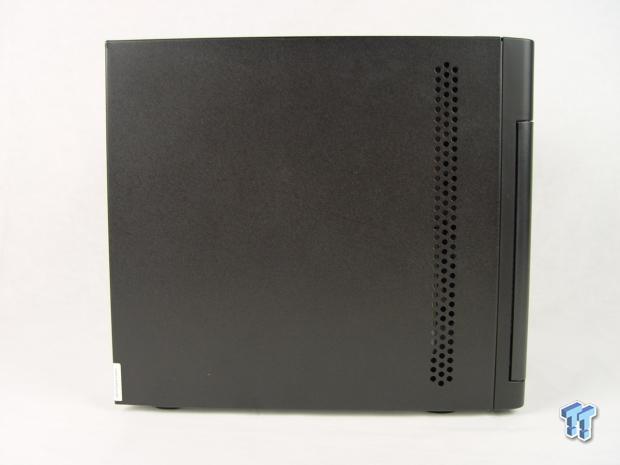
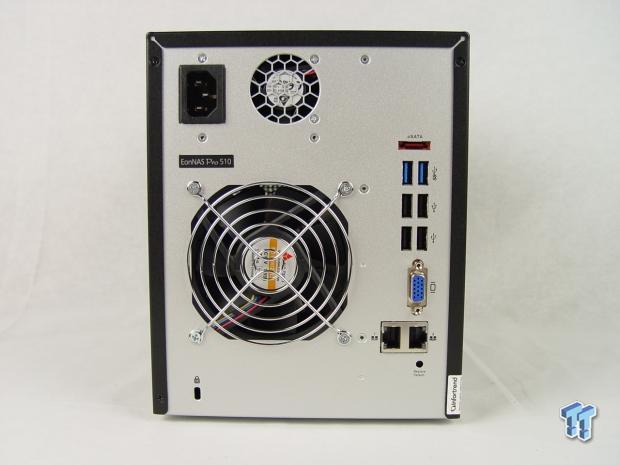
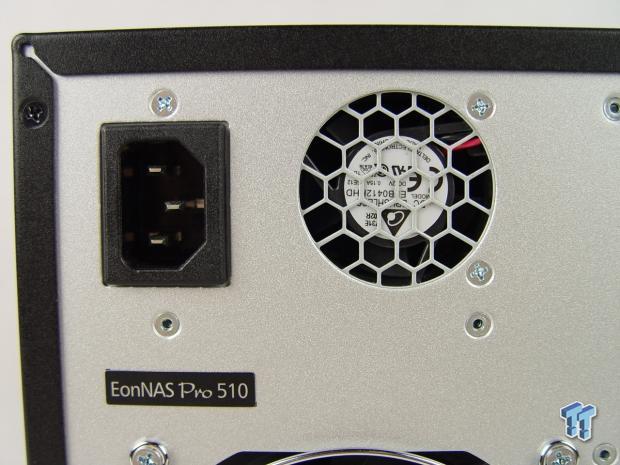
Infortrend uses an internal power supply so no power brick to deal with.
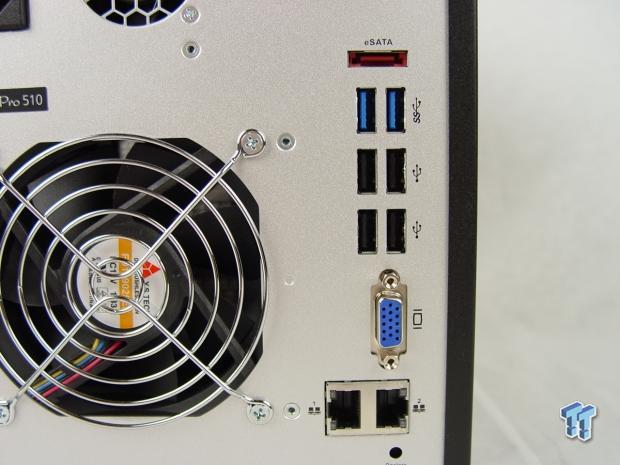
A large fan keeps the system and your HDDs cool. The two fans are quiet, we couldn't hear the EonNAS Pro 510 from a few feet away.
All but one of the I/O connectors are on the back of the NAS.
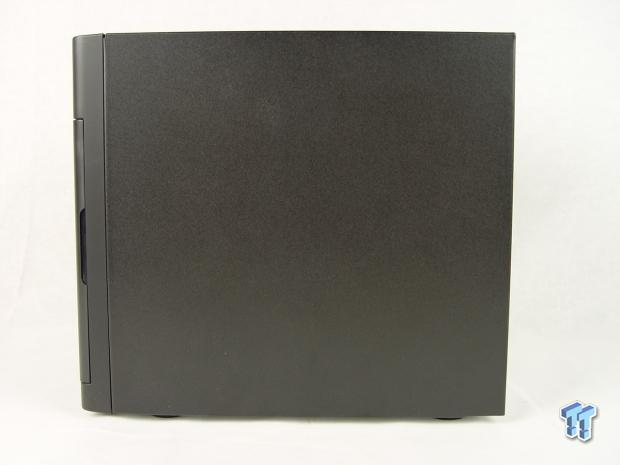

If you prefer to place your NAS on a desk the rubber feet help isolate vibration transfer.
Configuration Menus
Let's take a look at the web based configuration menus.
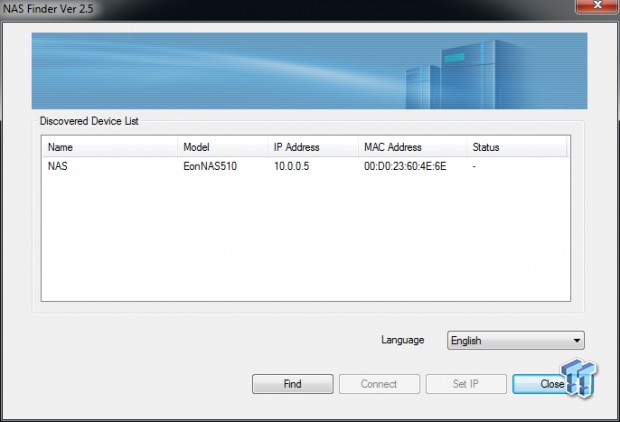
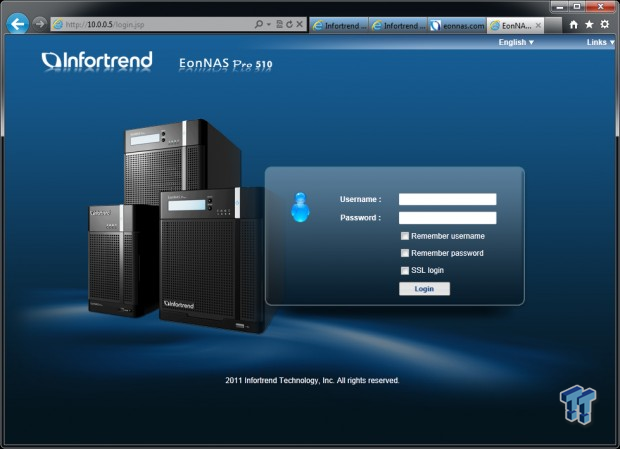
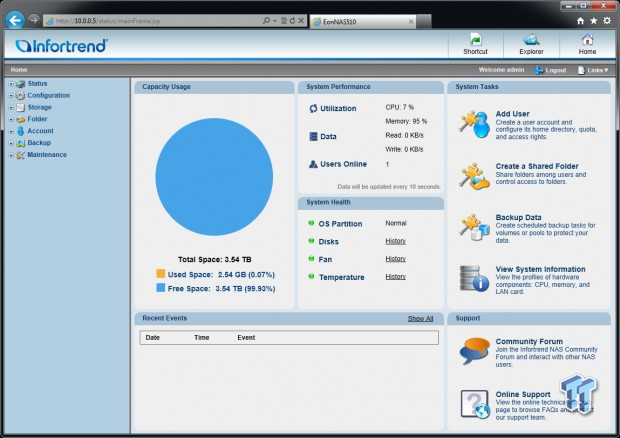
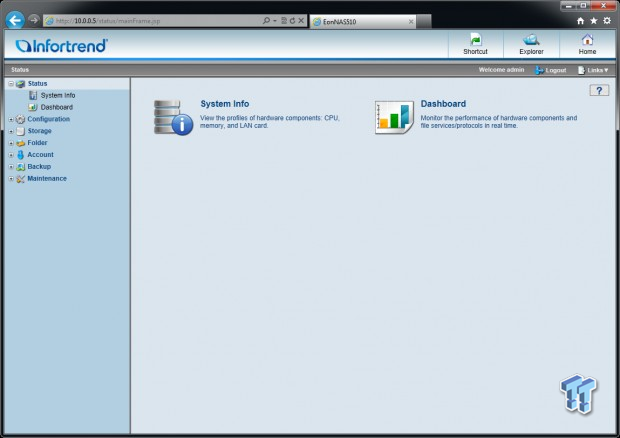
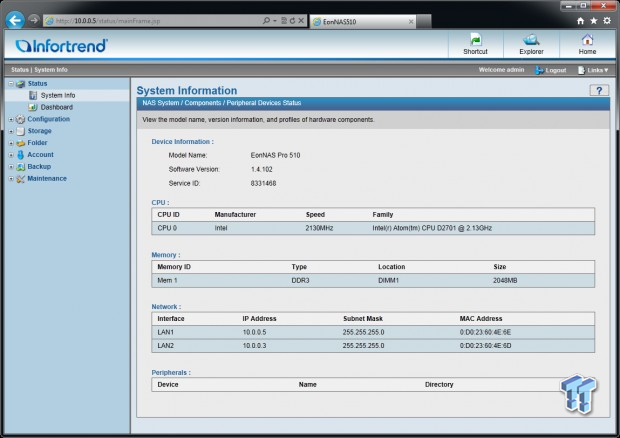
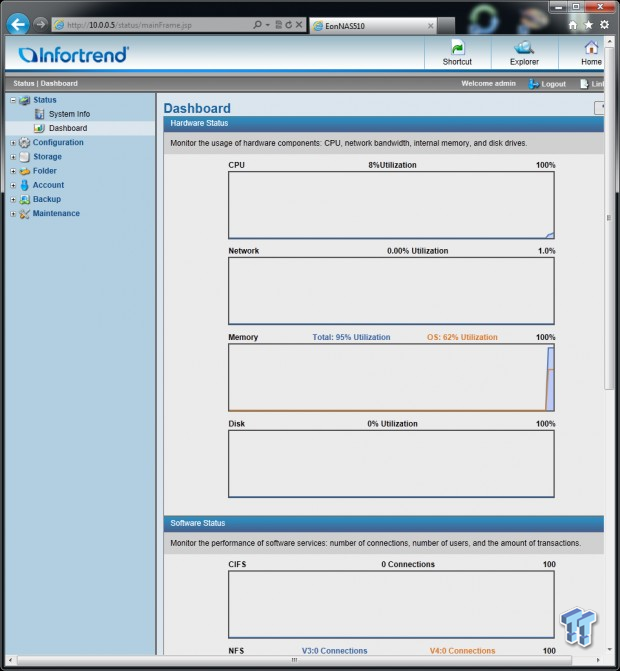
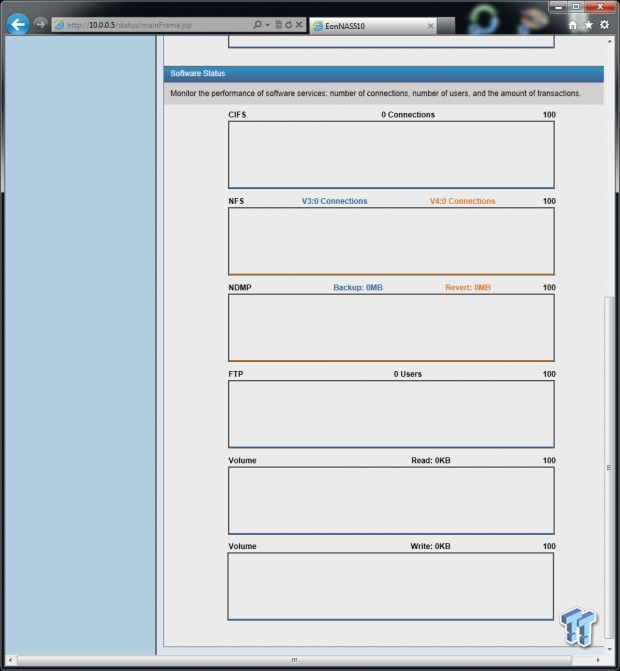

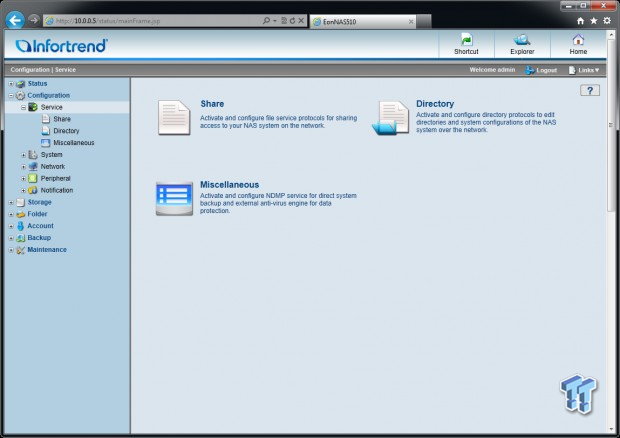
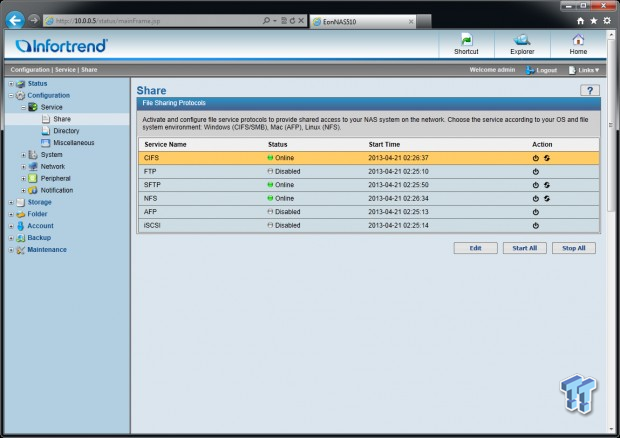
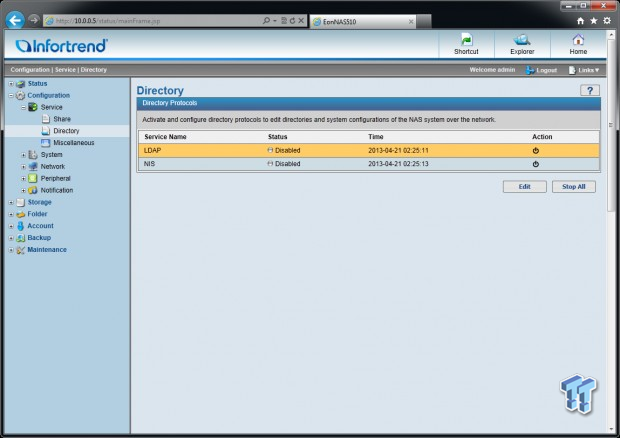
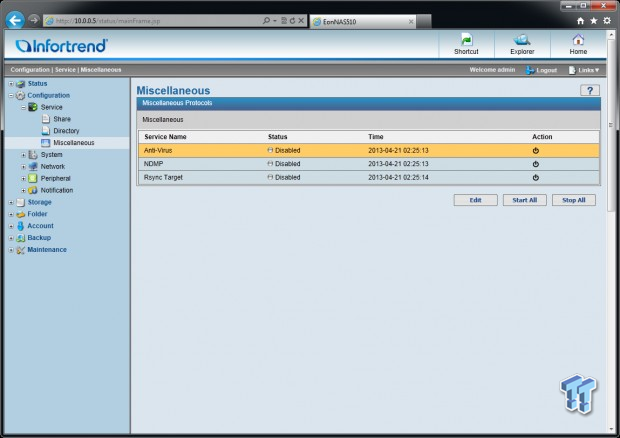
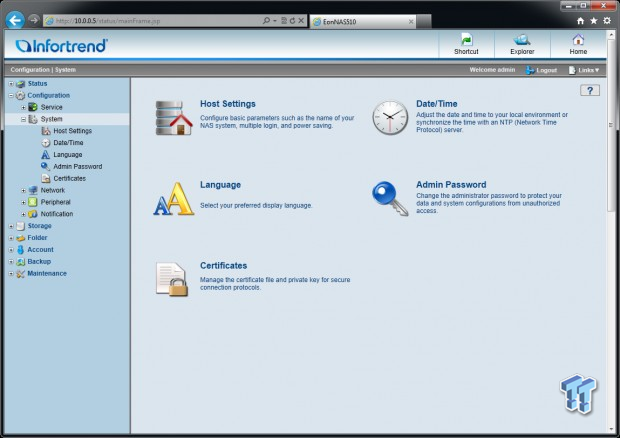
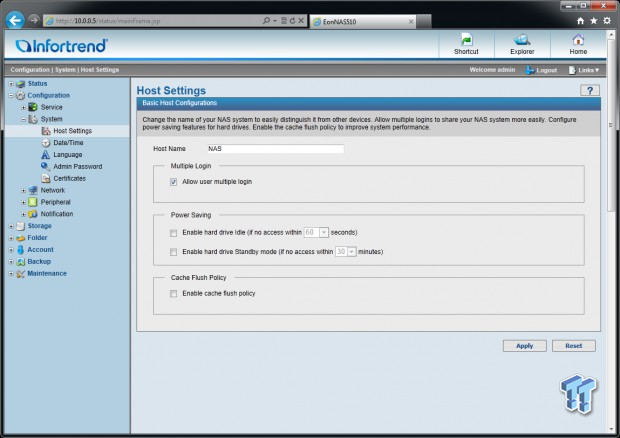
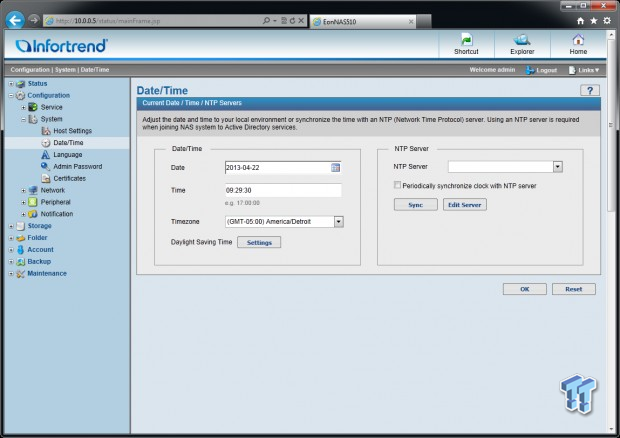
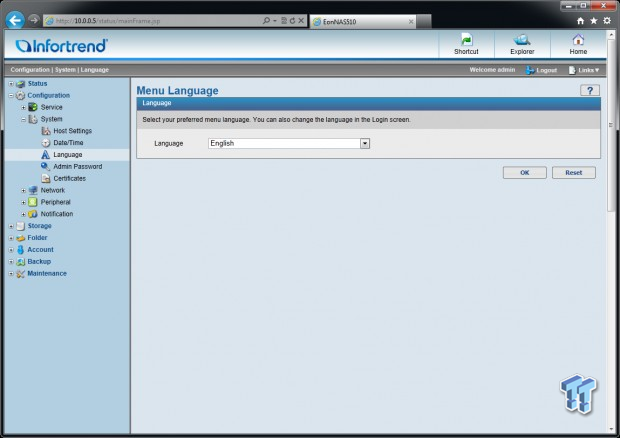
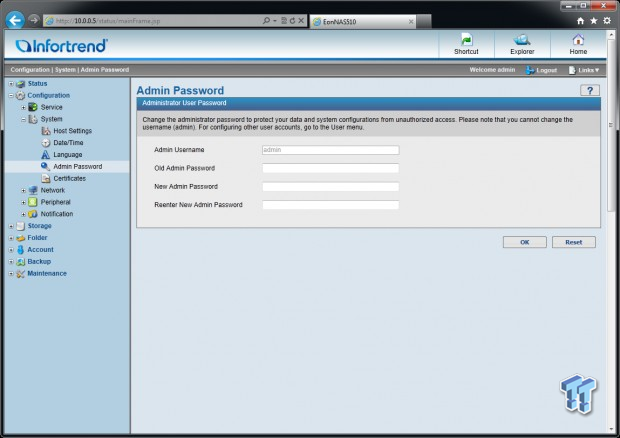
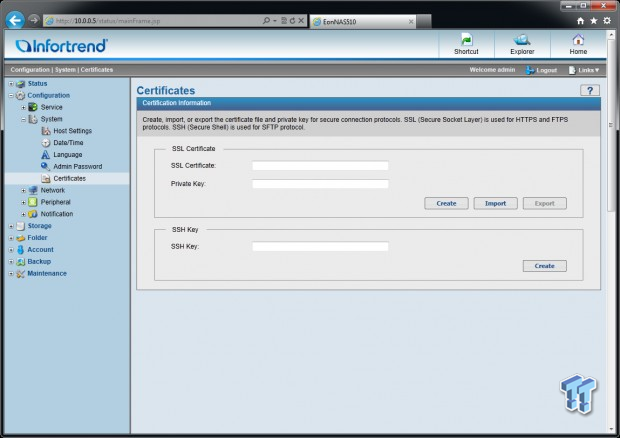
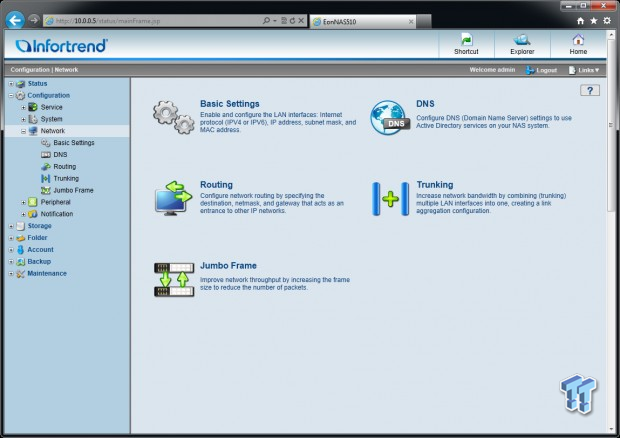
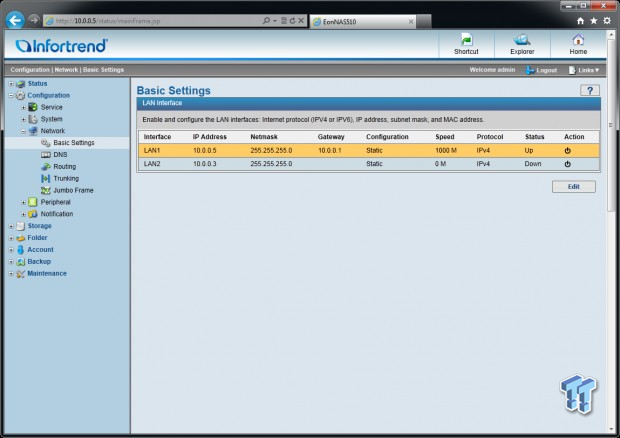
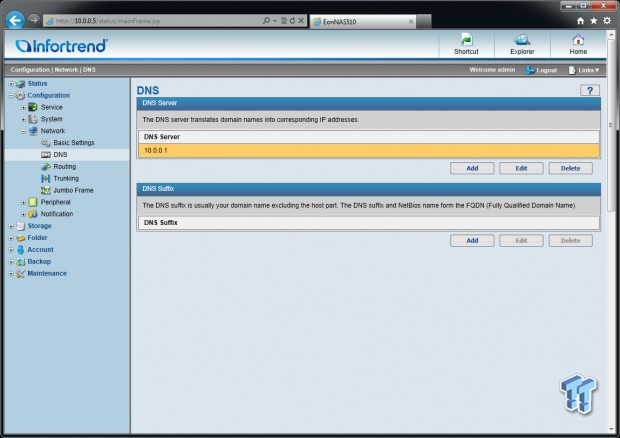
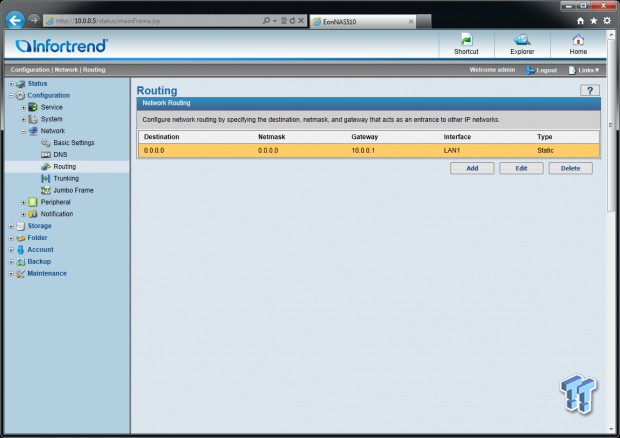
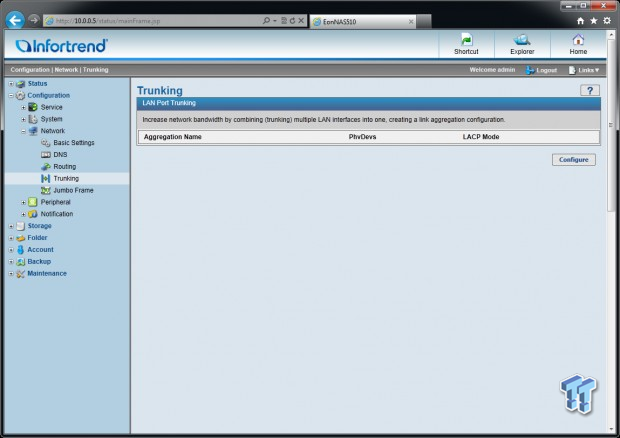
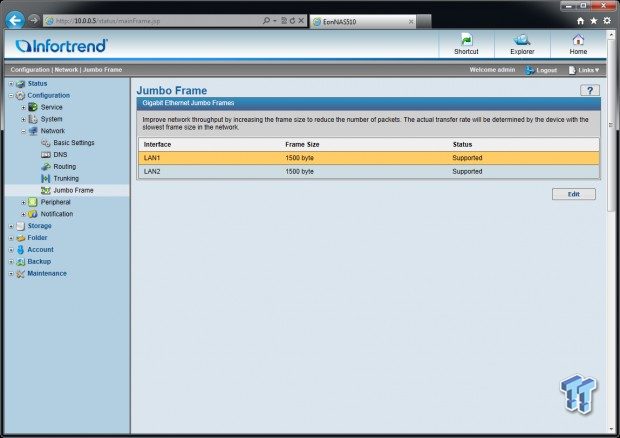

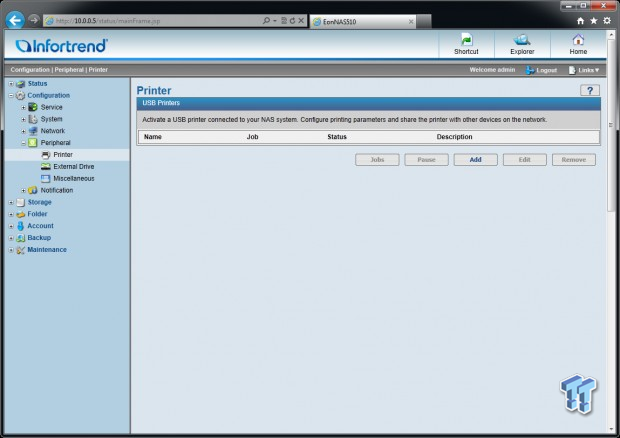
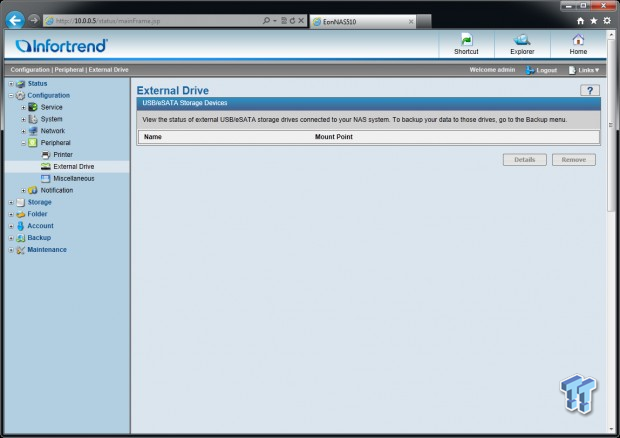
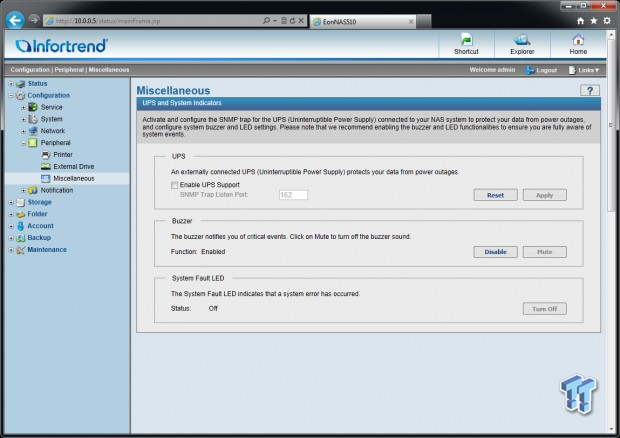
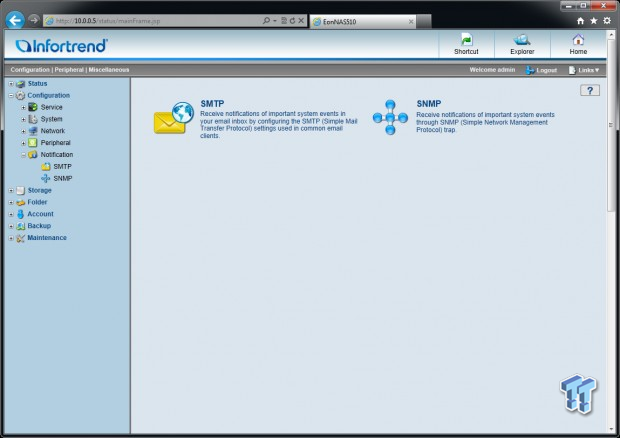
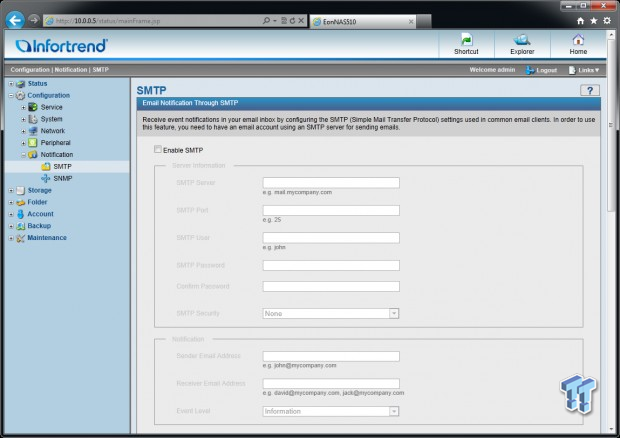

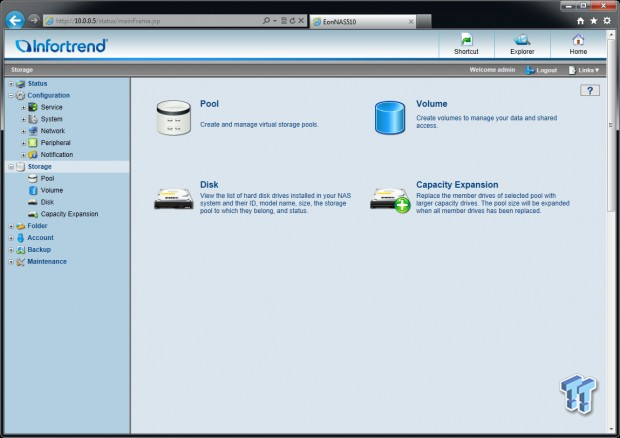
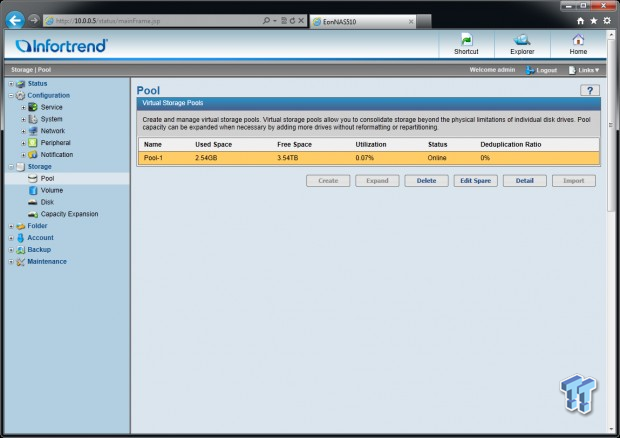
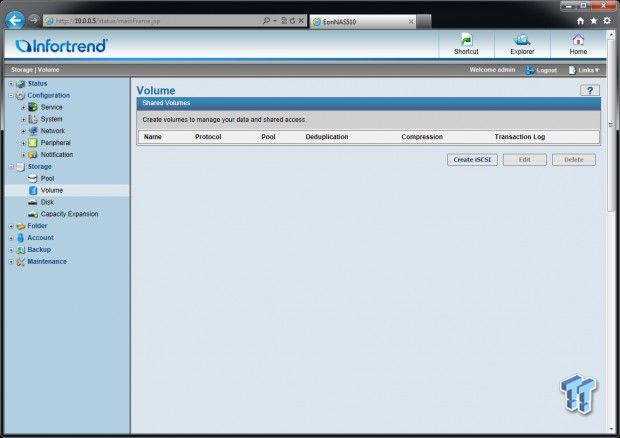

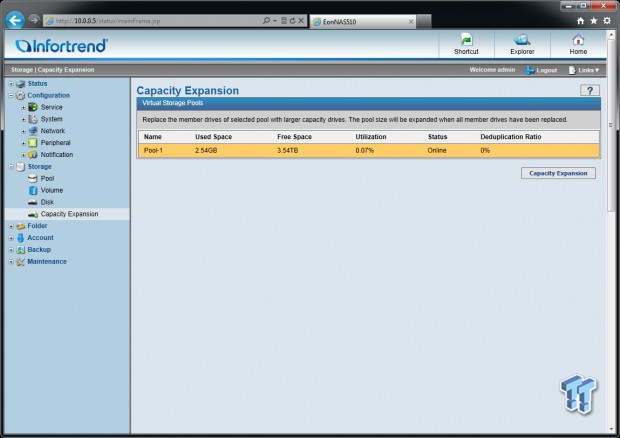
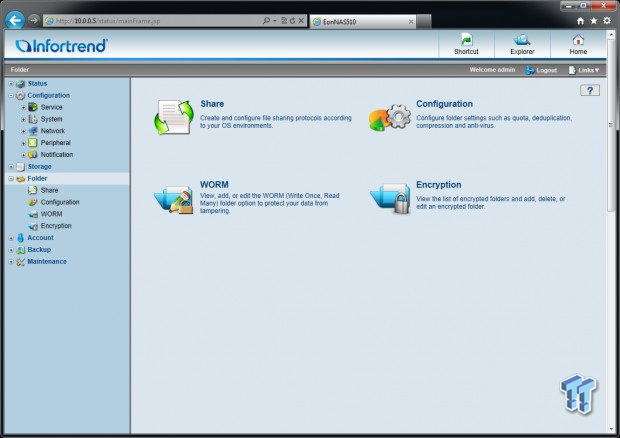
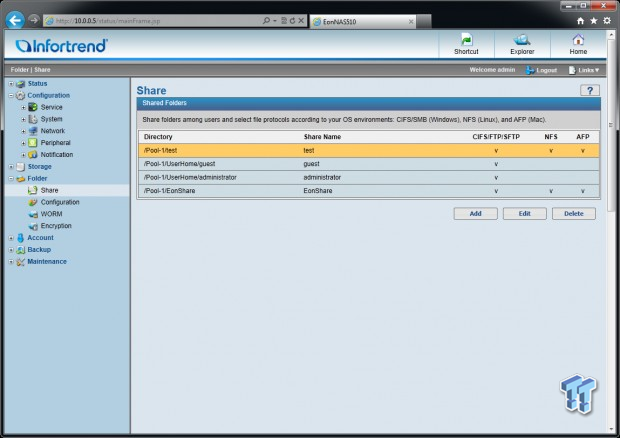
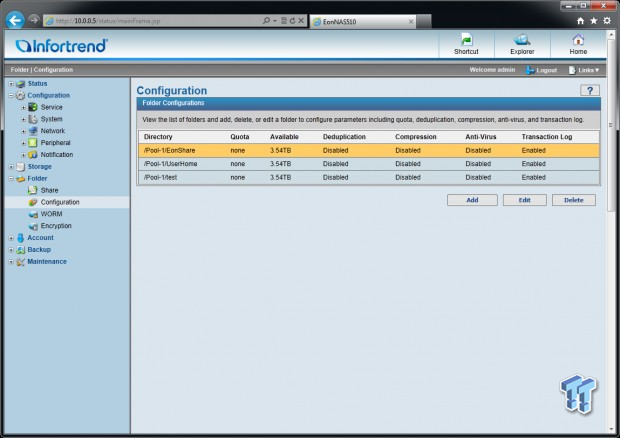

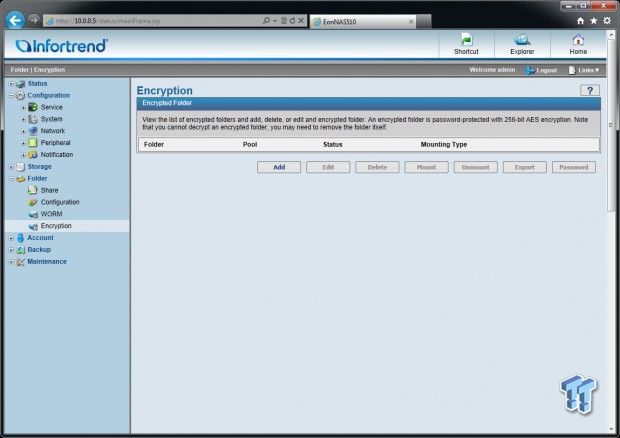
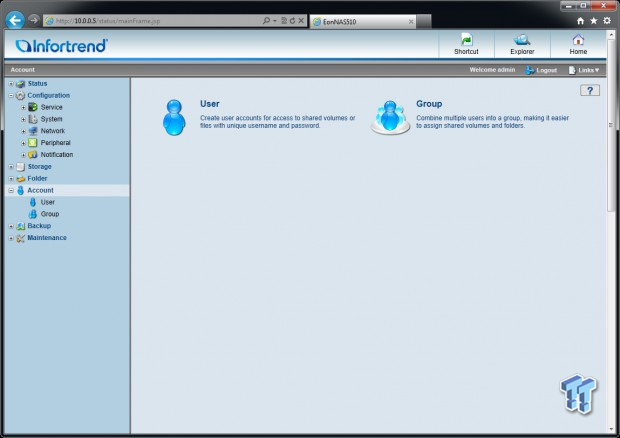
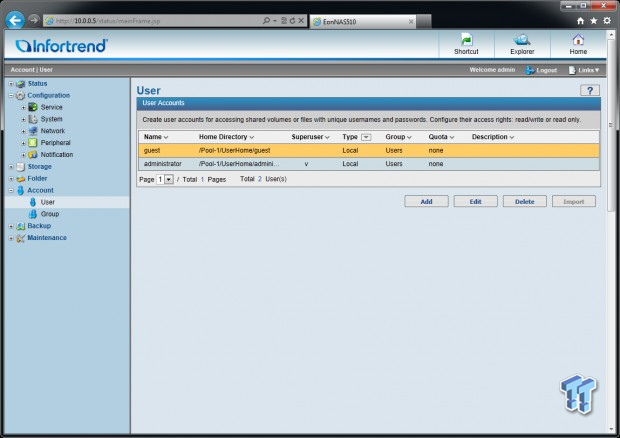
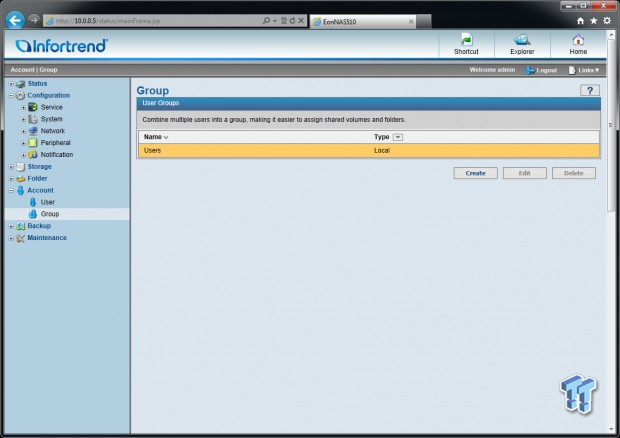
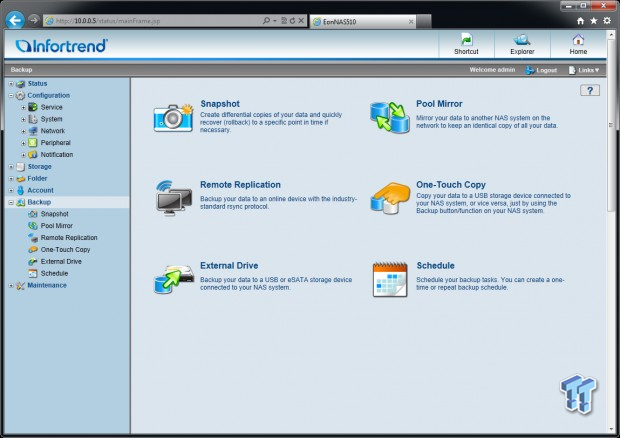
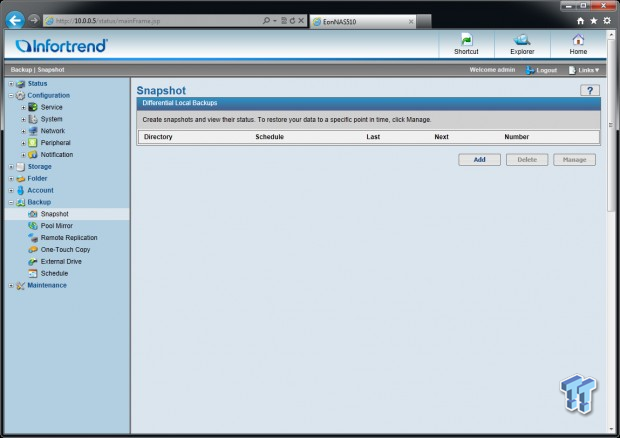
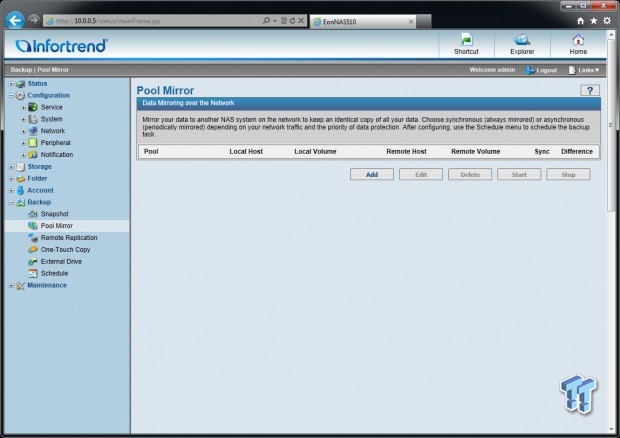
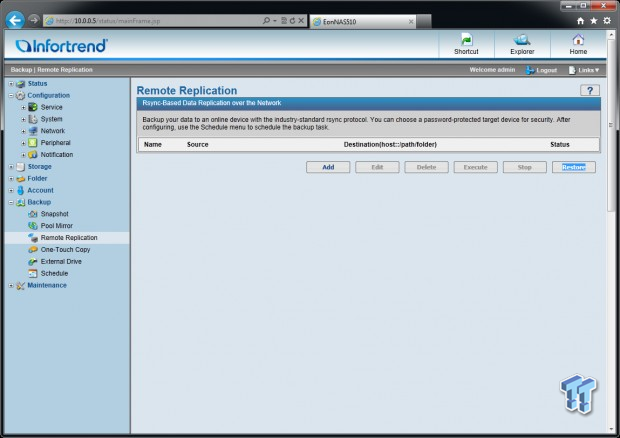
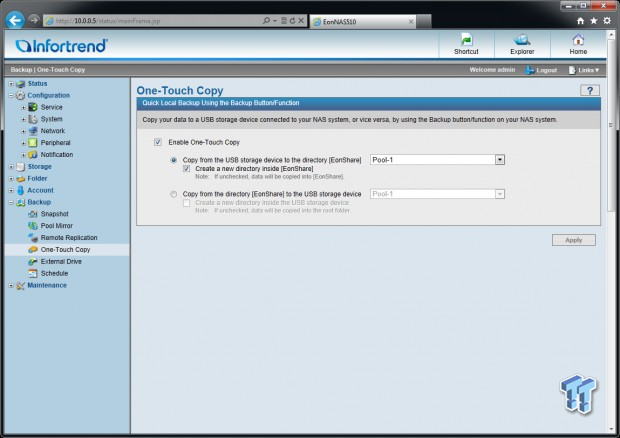
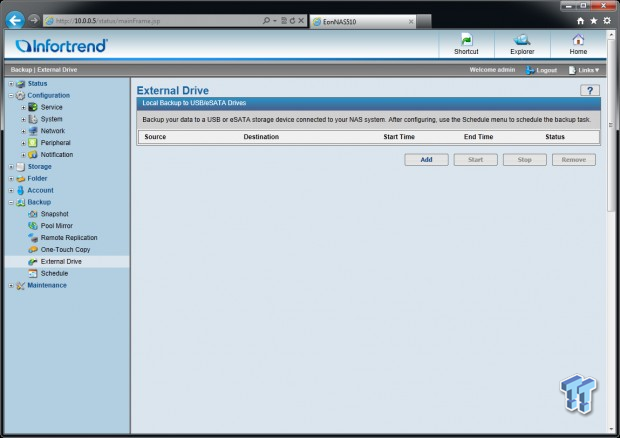
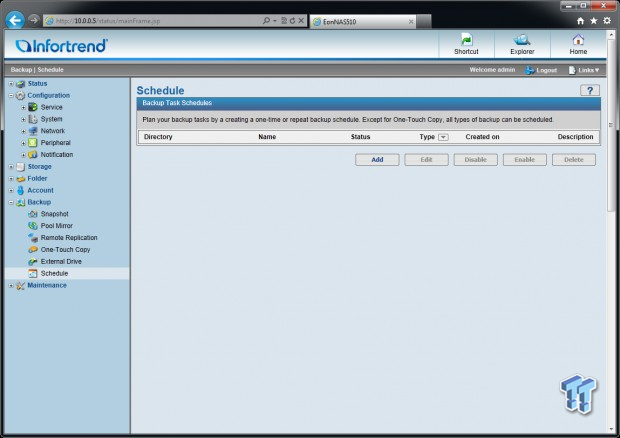
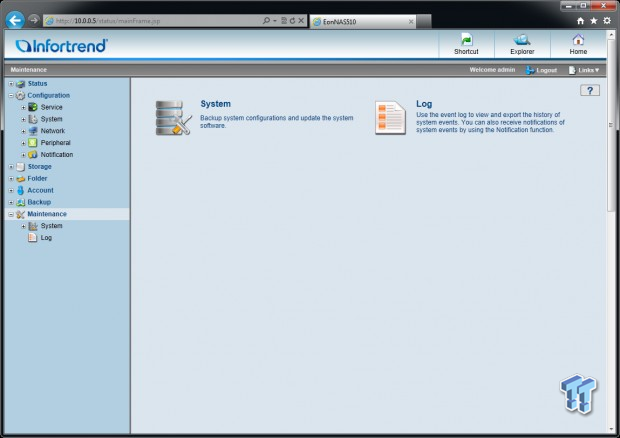
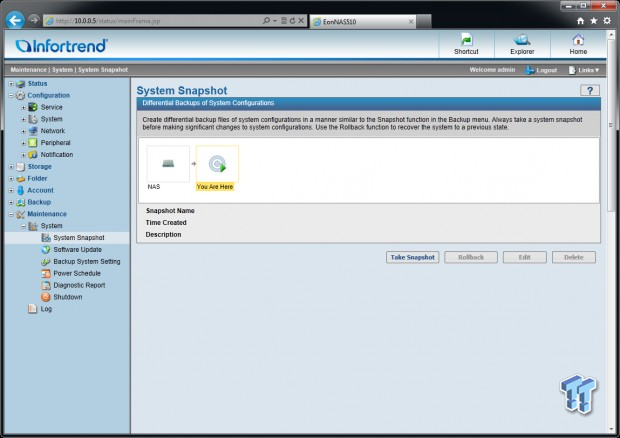
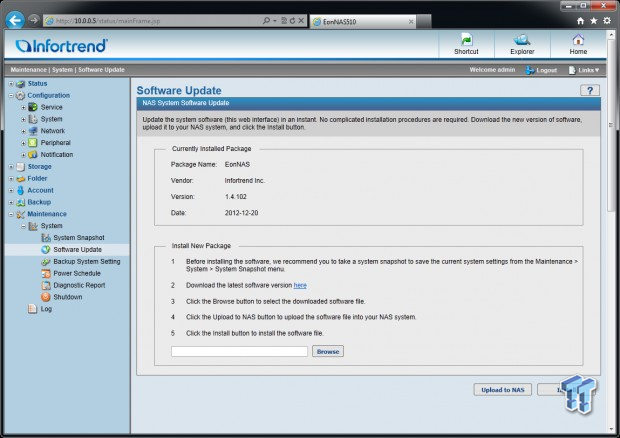
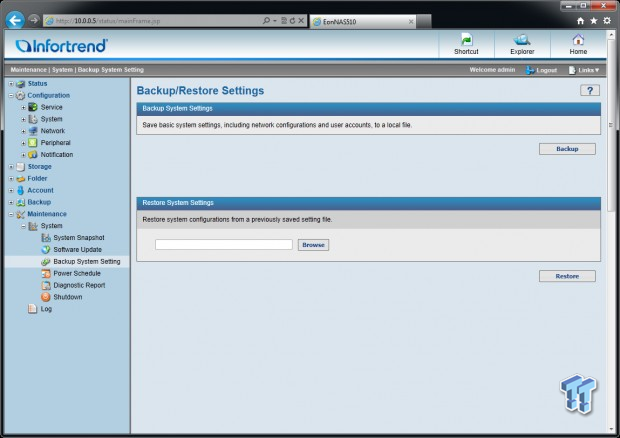
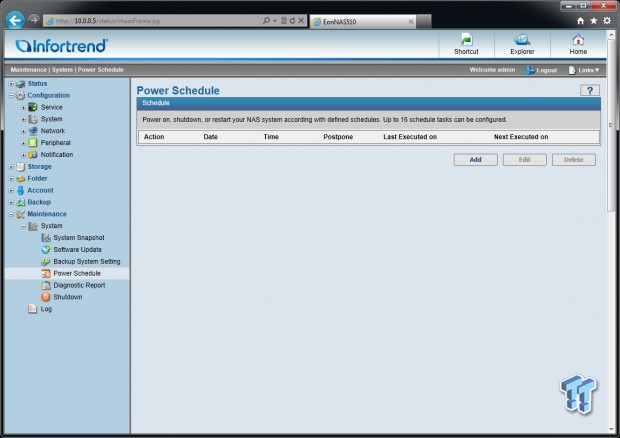
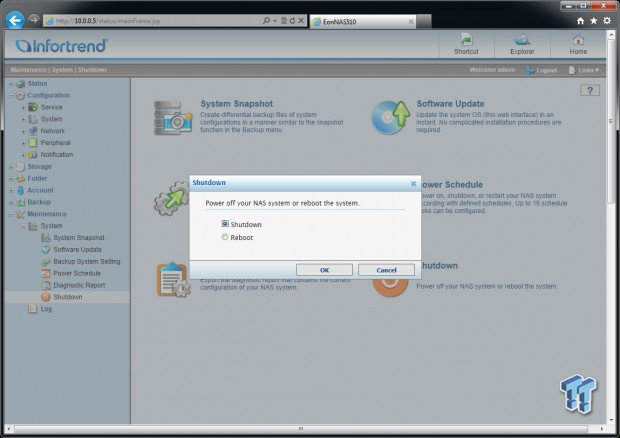
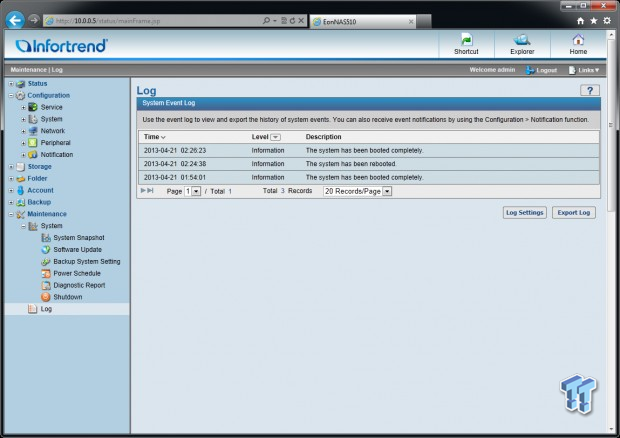
Test System Setup
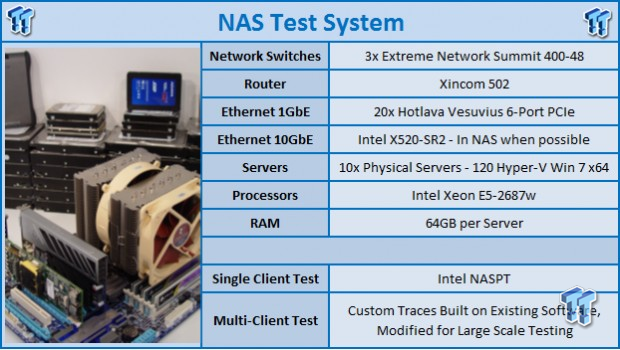
Our NAS test 'system' has migrated to a full 45u rack like what you'd find in a datacenter. There are ten servers that attack the target NAS with 120 Hyper-V installations of Windows 7 64-bit, each with a dedicated gigabit Ethernet port. The systems feed to three Extreme Networks Summit 400-48 switches that link together via Extreme Network's proprietary link cable system. One switch has a two 10GbE Xenpak adapters installed. When testing NAS products with 10GbE capability, the NAS connects to the switch via single or dual 10GbE courtesy of an Intel X520-SR2 installed in the NAS.
This level of testing wouldn't be possible without the help and support from several companies, many of which have little to do with NAS products. We would like to thank AVADirect, Antec, Corsair, Gigabyte, Icy Dock, Kingston, LSI, Noctua, Rosewill and Western Digital for their much-appreciated support.
Intel NASPT
The Intel NAS Performance Toolkit (NASPT) is a file system exerciser and analysis tool designed to enable direct measurement of home network attached storage (NAS) performance. Designed to emulate the behavior of an actual application, NASPT uses a set of real world workload traces gathered from typical digital home applications. Traces of high definition video playback and recording, office productivity applications, video rendering/content creation and more provide a broad range of different application behaviors.
TweakTown Custom 120-Client Office Test
The TweakTown Custom 120-client Office Test uses 120 Windows 7 Hyper-V installations and custom software to stress each NAS with traces from Microsoft Office tasks. Both throughput (in Mbits per second) and latency (in milliseconds) are measured.
Western Digital RED - The NAS HDD
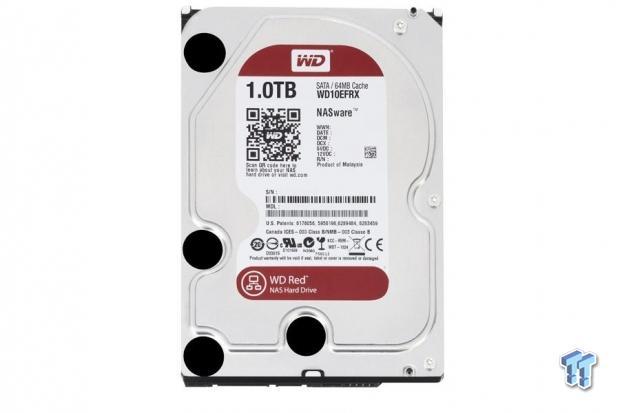
TweakTown uses Western Digital RED 1TB hard drives for all of our NAS tests. You can read our full review of the Western Digital RED 1TB here.
Benchmarks - 1 HDD / JBOD
JBOD: A single or combined multiple drives and capacities linked together to form a single drive.
Note - No Data Redundancy
HD Video Playback
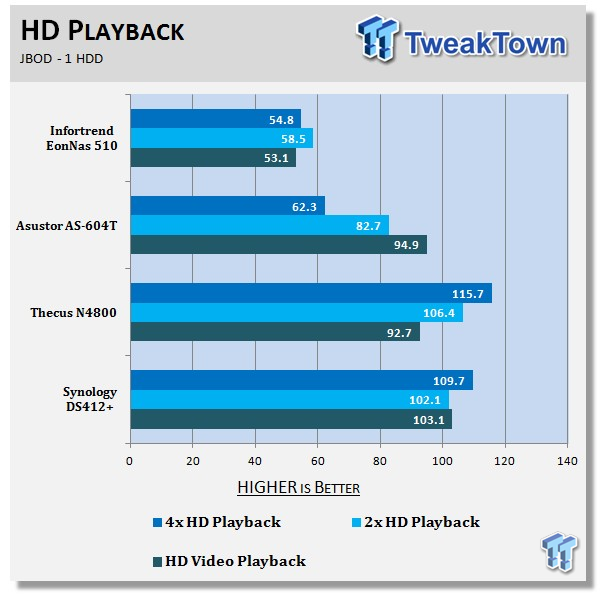
HD Video Play - 720p HD stream from Windows Media Player* 256kB reads
2HD Video Play - 2x playback
4HD Video Play - 4x playback
HD Video Record
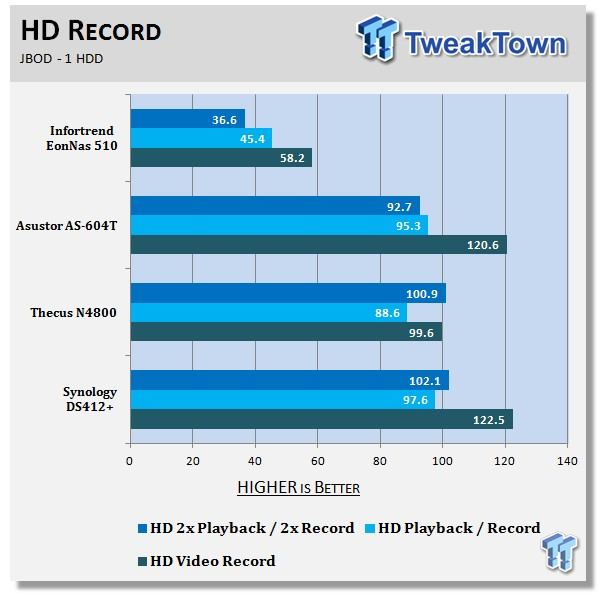
HD Video Record - 720p HD stream, 256kB writes
HD Video Play & Record - 1 playback, 1 record simultaneously
2x HD Video Play & 2x Record - 2 playback, 2 record simultaneously
Content Creation
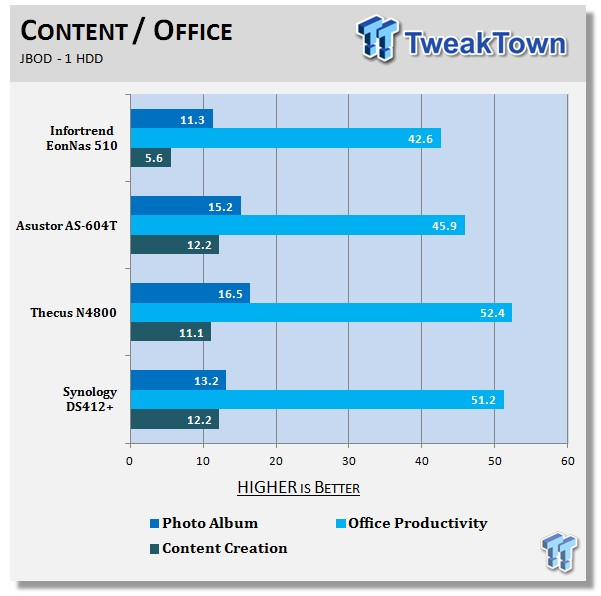
Photo Album - All reads - wide distribution of sizes
Office Productivity - Reads and writes, 1kB & 4kB reads; Mostly 1kB writes
Content Creation - 95% writes; 1k, 4k & little reads; Writes up to 64kB
File / Directory Transfer

Directory Copy From NAS - 64kB reads
Directory Copy To NAS - Predominantly 64kB writes, wide scattering under 16kB
File Copy From NAS - 4GB file copy, 64kB reads
File Copy To NAS - 64kB writes
One of the easiest ways to start with a NAS is to purchase your NAS and use an existing drive until more HDDs are purchased.
Benchmarks - 4 HDD / RAID 0
RAID 0: Normally used to increase performance and useful for setups such as large read-only NFS servers where mounting many disks is time-consuming or impossible and redundancy is irrelevant.
HD Video Playback
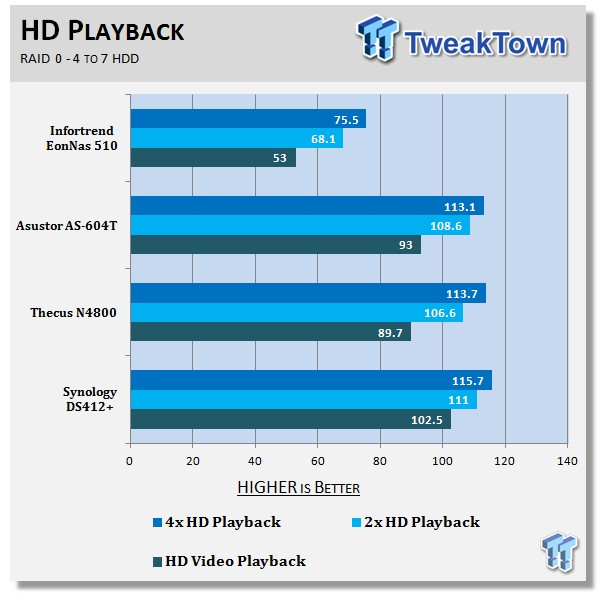
HD Video Play - 720p HD stream from Windows Media Player* 256kB reads
2HD Video Play - 2x playback
4HD Video Play - 4x playback
HD Video Record
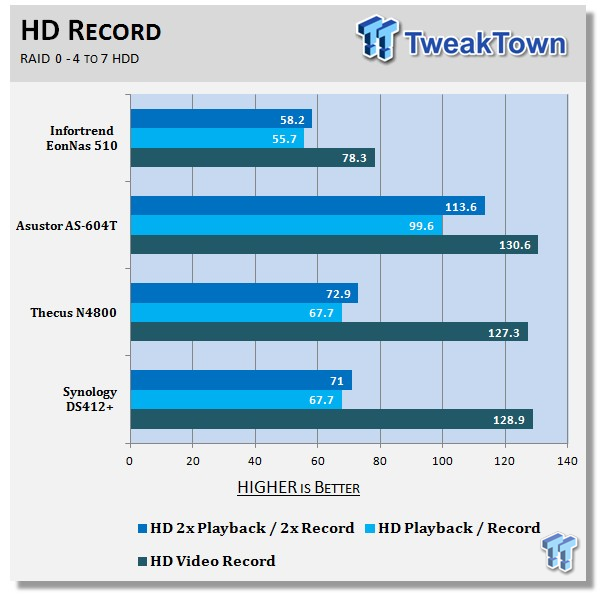
HD Video Record - 720p HD stream, 256kB writes
HD Video Play & Record - 1 playback, 1 record simultaneously
2x HD Video Play & 2x Record - 2 playback, 2 record simultaneously
Content Creation

Photo Album - All reads - wide distribution of sizes
Office Productivity - Reads and writes, 1kB & 4kB reads; Mostly 1kB writes
Content Creation - 95% writes; 1k, 4k & little reads; Writes up to 64kB
File / Directory Transfer
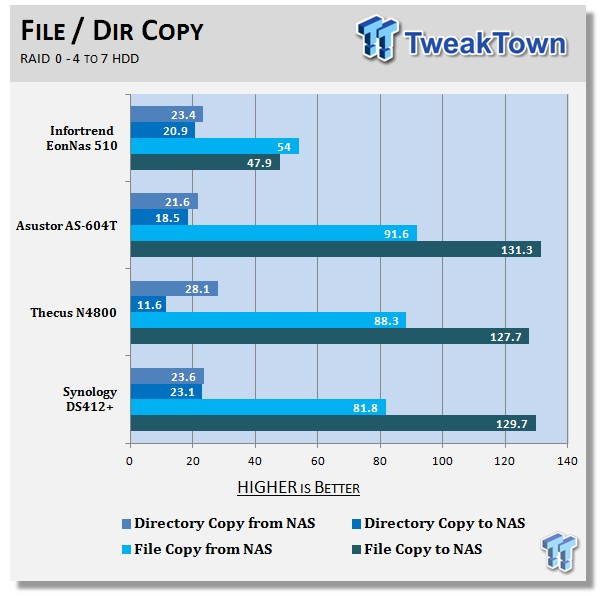
Directory Copy From NAS - 64kB reads
Directory Copy To NAS - Predominantly 64kB writes, wide scattering under 16kB
File Copy From NAS - 4GB file copy, 64kB reads
File Copy To NAS - 64kB writes
Benchmarks - 4 HDD / RAID 5
RAID 5: Use block-level striping with parity data distributed across all member disks.
HD Video Playback
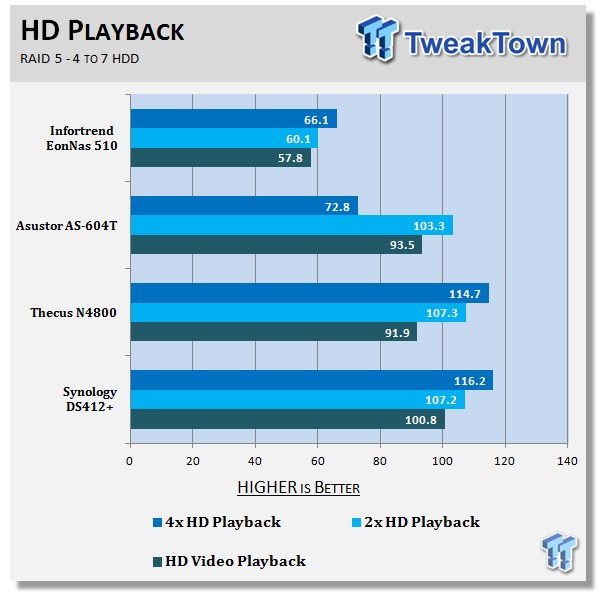
HD Video Play - 720p HD stream from Windows Media Player* 256kB reads
2HD Video Play - 2x playback
4HD Video Play - 4x playback
HD Video Record
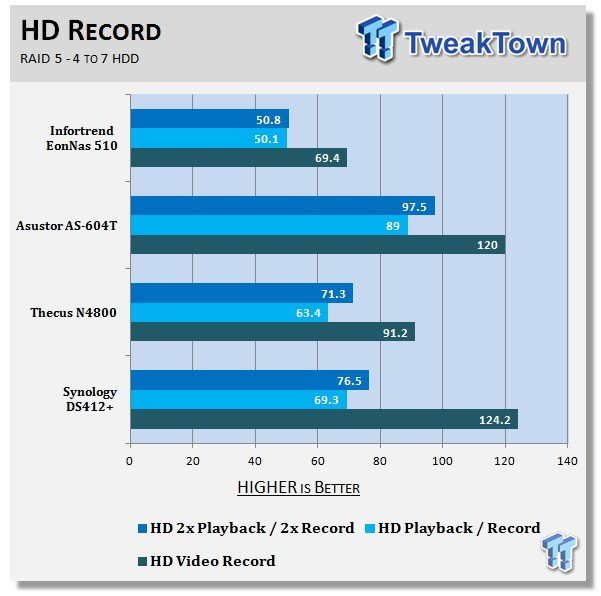
HD Video Record - 720p HD stream, 256kB writes
HD Video Play & Record - 1 playback, 1 record simultaneously
2x HD Video Play & 2x Record - 2 playback, 2 record simultaneously
Content Creation
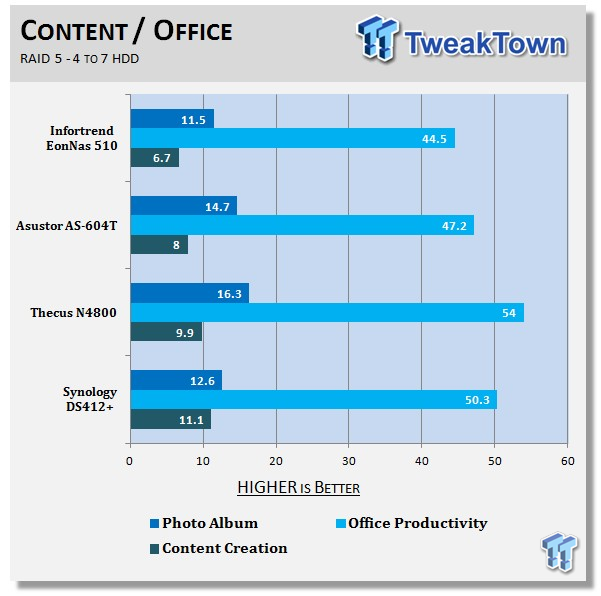
Photo Album - All reads - wide distribution of sizes
Office Productivity - Reads and writes, 1kB & 4kB reads; Mostly 1kB writes
Content Creation - 95% writes; 1k, 4k & little reads; Writes up to 64kB
File / Directory Transfer
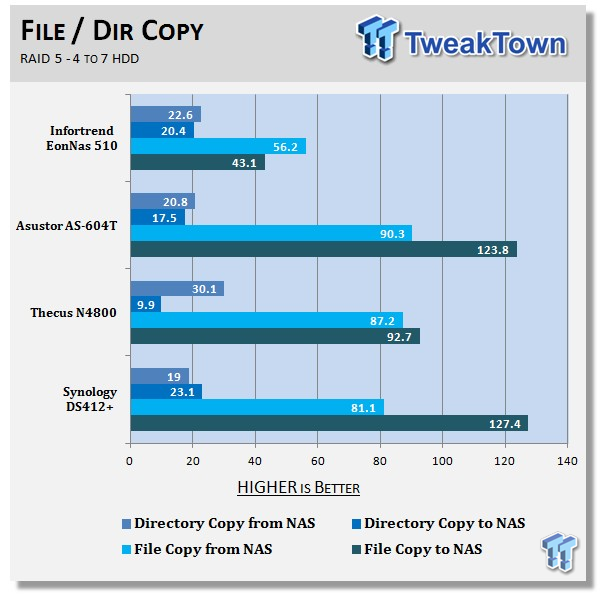
Directory Copy From NAS - 64kB reads
Directory Copy To NAS - Predominantly 64kB writes, wide scattering under 16kB
File Copy From NAS - 4GB file copy, 64kB reads
File Copy To NAS - 64kB writes
Benchmarks - 4 HDD / RAID 6
RAID 6: Extend RAID 5 by adding an additional parity block; thus it uses block-level striping with two parity blocks distributed across all member disks.
HD Video Playback
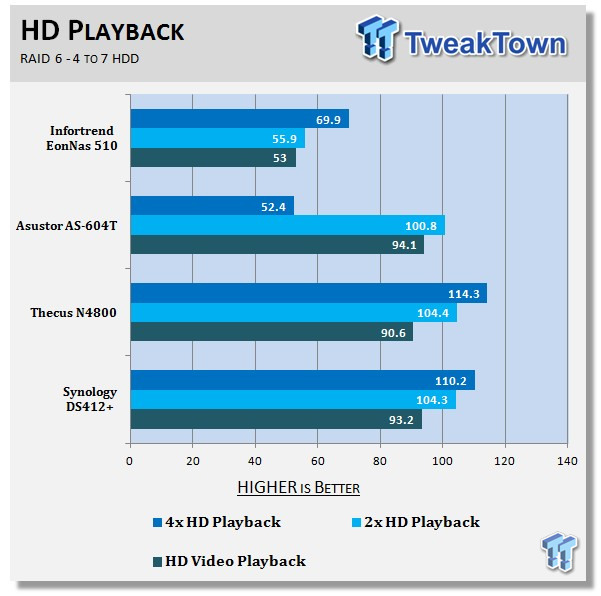
HD Video Play - 720p HD stream from Windows Media Player* 256kB reads
2HD Video Play - 2x playback
4HD Video Play - 4x playback
HD Video Record
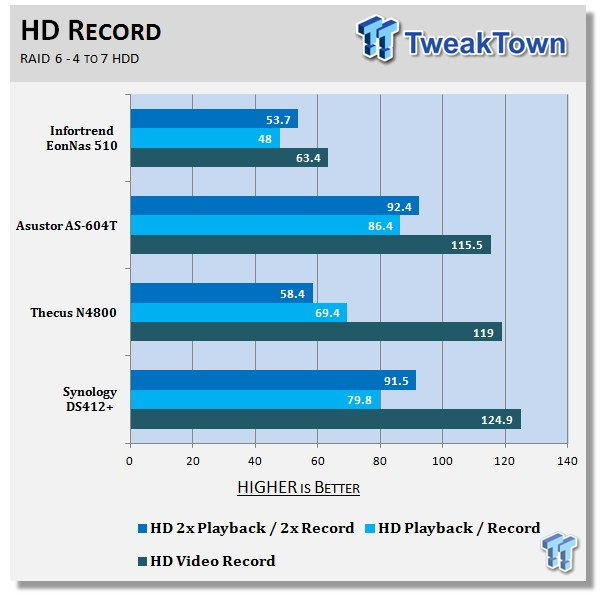
HD Video Record - 720p HD stream, 256kB writes
HD Video Play & Record - 1 playback, 1 record simultaneously
2x HD Video Play & 2x Record - 2 playback, 2 record simultaneously
Content Creation
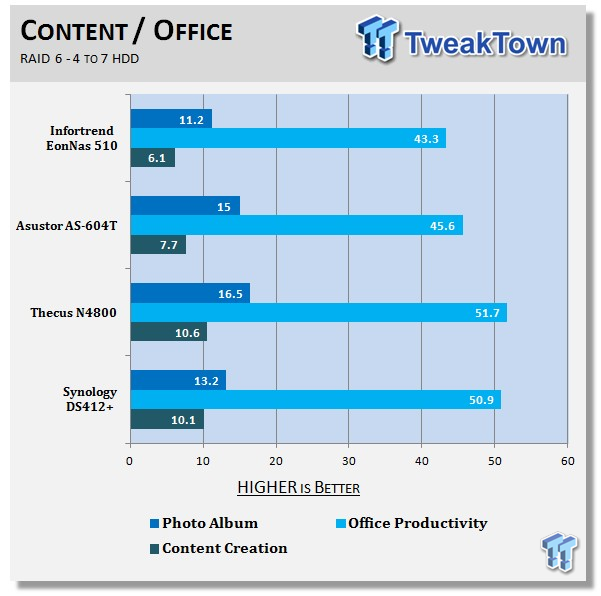
Photo Album - All reads - wide distribution of sizes
Office Productivity - Reads and writes, 1kB & 4kB reads; Mostly 1kB writes
Content Creation - 95% writes; 1k, 4k & little reads; Writes up to 64kB
File / Directory Transfer
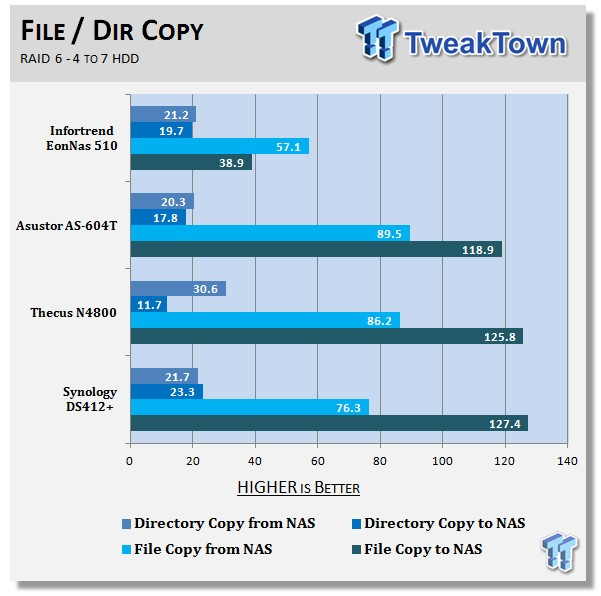
Directory Copy From NAS - 64kB reads
Directory Copy To NAS - Predominantly 64kB writes, wide scattering under 16kB
File Copy From NAS - 4GB file copy, 64kB reads
File Copy To NAS - 64kB writes
Benchmarks - Multi-Client Test
The Intel NAS Performance Tool (NASPT) is an excellent way to determine NAS performance in a single user environment. Any review that only uses NASPT assumes that only a single computer will access the target NAS at one time. We took issue with this method of testing and spent over a year designing, building, programming and finally validating the TweakTown Multi-Client Test.
The test uses Microsoft Office data recorded to traces and played back to the NAS from up to 120 client Windows 7 installations. We record total throughput and average response time per client.
Over time we'll populate the two multi-client charts with several NAS products from a span of categories ranging from a dual Xeon server with 2x 10GbE to a 2-bay NAS and then let the NAS being tested fall into its performance category.
Three to seven bay NAS are ran in RAID 5 and larger units over eight bays run in RAID 6.
Throughput
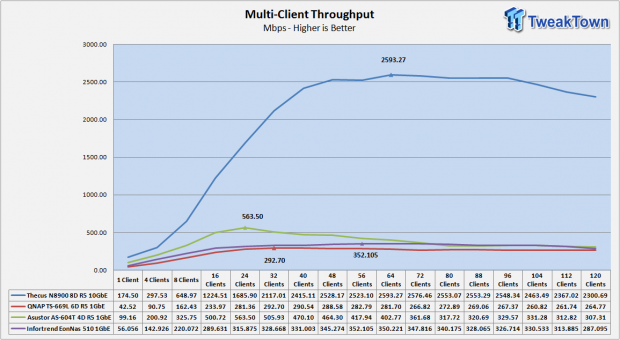
The Infortrend EonNAS Pro 510 delivers higher throughput than the QNAP TS-669L, a six-bay NAS that uses the same Intel dual-core Atom running at 2.13GHz. Compression and dedupe are off in these tests. The EonNAS Pro 510 achieved peak throughput at 56 clients in our custom multi-client test.
Latency
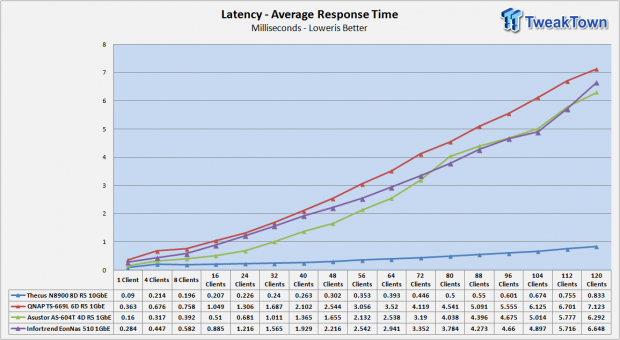
At 56 clients the latency was still below 3ms at just 2.542ms. Here you can see the large separation between the TS-669L and the EonNAS Pro 510 in latency.
Final Thoughts
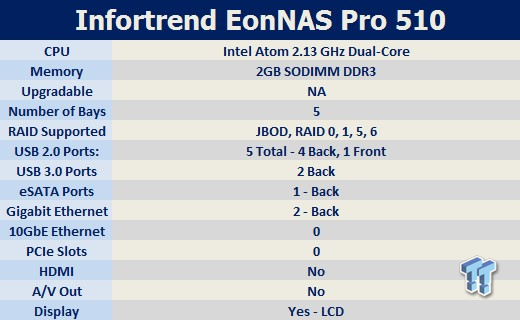
At the time of writing we weren't ready to unleash our three newest benchmarks coming to TweakTown NAS reviews. Database SQL with built-in NAS SQL services, Windows 2012 iSCSI SQL and Boot Storm will appear in the NAS dedupe article, which is coming soon. We wanted to include a section on the EonNAS Pro 510 deduplication feature in this article and then realized after the fourth page that the article was quickly turning into a data dedupe article, and not a review of the EonNAS Pro 510. NAS products ship with a very wide range of features. Oddly enough, Infortrend doesn't include the typical consumer services we find in units from the other big names in the affordable NAS market, but the enterprise features make the new EonNAS Pro models just as diverse in features. Data dedupe in an incredibly powerful addition to this market, as you'll see soon.
In our single user tests with Intel's NASPT benchmark software, the EonNAS Pro 510 was down on performance in the JBOD and RAID 0 tests. RAID 5 and RAID 6 even the performance a little more in the Content Creation and Office Productivity tests. The single user performance is good, but not great. The NAS is tuned for enhanced performance with smaller file sizes, like what's used in your office.
In our multi-client test, the EonNAS Pro 510 outperformed the QNAP TS-669L, a 6-bay NAS with the same processor, in both throughput and latency. That said, the QNAP TS-669L isn't bad and the Infortrend EonNAS Pro 510 isn't exceptional either. Both products are outperformed by the ASUSTOR AS-604T. The Infortrend caught up to the AS-604T at 80 clients, but it goes to show that Infortrend could and should work on performance a bit more. The upgradable firmware makes this possible once Infortrend has new firmware ready.
Home users should pass over the EonNAS Pro 510, but that statement will go over fine with Infortrend. This is a business NAS with a lot of true enterprise features. The feature set is a step above what we've found on many other products in this price category, even products costing three times more. You'll see soon the power of data dedupe with both HDDs and SSDs - it's an excellent feature for businesses and with SSDs, the NAS performs much better in the boot storm and database tests.
For business users the Infortrend EonNAS Pro 510 delivers features galore and gives administrators easy configuration options without consumer feature distractions.

